Photoshop CS6 and natural needs
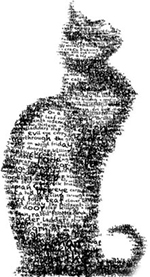 Hello.
Hello.Having read and seen enough clips and other promotional materials for Photoshop CS6, I felt an understatement and decided to test it myself.
Since I do not understand the point of creating specially fitted examples to demonstrate new features, we will test them on daily needs, namely:
1) Photo manipulation
2) Working with the interface (website and mobile application)
3) Typography
4) Creating illustrations and vector chips
UPD 1: A little testing of performance and stability.
So let's go.
')
Have you seen the cat upstairs?
It is this typographical kote and it seems to have become a new starting prettiness of Photoshop CS6, at least in the beta version.
I was a little embarrassed by the Superstition inscription instead of the expected Photoshop, but only a little, because right after that I was awaited by a far greater cause for embarrassment: I need Adobe ID, otherwise no one is going anywhere.
Total, at start and right after - the first impression:
1) You need an Adobe ID, which, by the way, was also required during installation, but there you could skip it, but there was no way. True, I had it already installed in Adobe Editions and Photoshop even tried to pull it automatically, but it did not work out - I entered it with my hands.
2) Apparently, as a reward for some dances with this ID, you get not 30 (like in CS5), but 60 days of the trial period , and in the starting window a bonus in the form of useful links on youtube - reviews, online help and t .d
 . Reminds 3D Max with their lessons.
. Reminds 3D Max with their lessons.By the way, the online help at the time of writing the review was not available.
3) It really is faster. Both in loading, and in work.
4) It is dark. But this is fixable, since there are 4 color schemes of the interface to choose from.

5) By default, the interface profile is sharpened for 3D. I think this is because in the list of profiles he alphabetically goes first, but Photoshop is still mostly not for this. Although, judging by the development of this tool, more and more integrate modeling and control of simple and not very three-dimensional objects.
6) When running CS6, Photoshop CS5 does not start. That is all. Instead, it starts the sixth. A session of simultaneous
What immediately caught my eye: Timeline at the bottom of the window, and the Timeline is very similar to the greetings from AfterEffects, even the layer filters are the same.
Naturally, I could not resist and tried to throw a random avi-file there.
My friends, it was not there. I saw the audio track, the video - no. Apparently, we will deal with bitrates later.
By the way, the animation panel is also integrated there. I expected to see another hello, already from Flash, but not - a simple frame-by-frame for gif-animations.
 But it's time to switch to more familiar profiles for working with graphics.
But it's time to switch to more familiar profiles for working with graphics.And what do we see?
Separate profile with novom. Conveniently, what is there.
You are immediately hinted at where and what to look at first.
And we will see, in order and gathered.
By the way, what I liked right away when preparing screenshots is:
The new mechanism of the tool Crop (Cropping) .
First, immediately when choosing a tool, a frame appears along the border of the image, which is convenient to pull and the old stretching mechanism is not removed from the specified area. Secondly, you can track the appearance of the frame before and after cropping in the process. In general - pleased.
I tried on groups of large images. Compared with CS5 - significantly faster and frames, and moves. On a work computer, this is not so noticeable (all the same, 16 gigabytes of RAM and core i7 make themselves felt), but on a laptop it is noticeable.
Looking ahead, I will say: this is felt most strongly in 3D - modeling. True, the problem with not too high-quality export of polygonal models was not fixed - fragments are sometimes lost.
But, in order:
Useful for everyone:
1) In my opinion, the absolute leader of the rating: Autosave . The end of third-party pribludam and writing their action games for Avtosave. Now you can set it up culturally.
2) Search by layers. On closer inspection, it turned out to be just a bomb, especially for working with interfaces.
You can search-sort by:
- layer type
- attribute,
- mode
- name,
- effect applied, etc.
There are a lot of opportunities, in particular, both in automation and in accelerating work (especially in making edits).
Search filters can be used both individually and several times at a time.
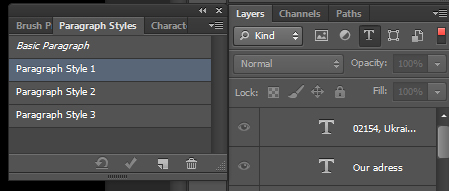 Example: you have a website or interface layout in which you need to globally change the style of the font or buttons.
Example: you have a website or interface layout in which you need to globally change the style of the font or buttons.Open it and sort the layers, say by type: Text.
Then try another novelty from CS6: Paragraph Styles . Click, and all the texts in our new form.
By the way, remember this pestering allert: “Could not commit / move ... because the layer is locked”?
So when filtering layers, the search for this gadsky zalochennogo layer takes 5 seconds.
I experienced similar sensations when in CS4 it became possible to open images not in windows, but in tabs.
3) Paragraph Styles and Character Styles The most interesting thing described in the previous example, and on the new font settings we’ll stop when looking at typography. I can only say that it works especially courtly in combination with the preliminary filtration of the layers by type.
4) New Crop (Crop) mechanism. See above. And be sure to try his Straighten setting - a curious thing.
5) Ctrl + J. Now it works not only on the layer, but also on the group. As far as I can remember, I have configured the keyboard shortcut “Ctrl + Shift +,” for the same purposes.
6) Create clipping mask. Now it works not only on the layer, but also on the group. It helps a lot with photo manipulations and drawing - no extra masks are needed. (There was a question, so I’ll clarify: an object can be "slipped" onto a group, on the contrary, it is not possible so far without coverting into a Smart Object.)
7) Floating tooltip: this is practically the replacement of the Info panel. At least with operations such as selection, framing, positioning, so accurately.
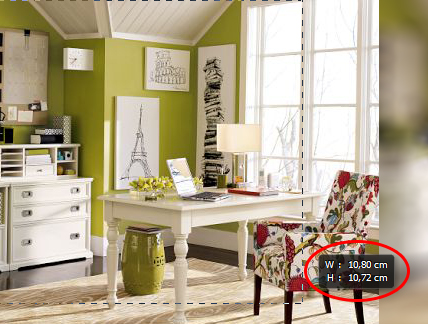
Photo manipulation:
1) Camera Raw 7. No comments here. Waited? Waited. You can describe in detail on the whole article. From the most enjoyable: Highligts / Shadows / Whites are edited by curves, and in general the settings have become much more. That is, now you can do a lot of good things even without direct loading in Photoshop.
2) Filter Iris Blur . Well, what can I say: Akvis is still, of course, not so resting, but FocalPoint is already worth thinking about. Another little bit of settings would be fine. So far, just very good.
I will not describe in detail - I'd better show:

And this is in one click with basic settings. Not bad, right? With the effect of a photographic lens does not compare, of course, but in my opinion, not bad.
3) Filter "Tilt Shift". Essentially the same, but not radial blur, but straight. Very convenient, by the way the interface of the filter itself is thought out easily achieve precise settings even with a mouse.

4) New nyashechki in Mini Bridge. I will not elaborate in detail, but subjectively: everything is twice as fast.
Work with the interface.
1) The layer filter (described in detail above) will raise Jedi skills when working with several screenshots and groups of layers at the same time to a new level.
2) Floating tooltip (also described above). Especially convenient when placing lines - you can immediately see where you are and where you are.
3) There are templates for popular mobile interfaces (smartphones and tablets).

Explain to me: What was it worth signing them? At least tentatively? At least the main?
Offhand, I recognized only the iPhone (Retina and not Retina), the basic Android (smart and tablet) and Blackberry.
The rest is a mystery.
And most importantly: I did not find anywhere in the settings how you can sign it yourself. You can, of course, create your own preset and sign there, but “Why is that?” (C)
Typography:
1) Ability to create custom style libraries for Paragraph Styles and Charachter Styles.
2) Added quite a few font settings.
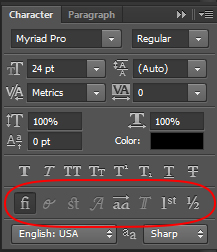
As we see, along with standard kerning, tracking, and leading, we get a lot of new ones, for example, the same Contextual Alternates. For non-typographers, this is something like this:

Well, the most delicious, finally.
Creating illustrations and vector chips
1) A lot of things added to the default-sets.
New Shapes in a standard set, and with a hint of abstraction.
New presets brushes, which are very clearly visible effort to improve the quality of work with the tablet. And rightly so, I think.
2) Dotted contours of objects . Yes. They are here. They came.
Just not from that turn. After reading about such a chip, I was one of the first to search for her. Where do you think it is?
That's right: in the styles of the layer, and more specifically Stroke (Contour). As you probably already guessed, no one there was waiting for me there, beside the standard solid contour, so I had to study the materiel in-depth.
They were already found here:

In the settings of the shape.
You can also play with rounding corners, the location of this stroke (inside, center, outside), style, size, etc. In general: we forget about the textual shading that goes along the Shape.
And an interesting effect: the use of this circuit does not cancel the standard Stroke. Curious results can be achieved, in particular a double loop with a gap.
In general, Shape was thoroughly refined (I think it was lobbied by designers who didn’t have Illustrator installed, so that designers could work with vector also in Photoshop), starting from the fact that now you can quickly and beautifully play with fill in the Shape panel and finish with the Shape thumbnail in the layers panel is now visible not just a color square and next to it a vector layer mask, but a full picture.
To summarize the first acquaintance with Photoshop CS6.
Pros:
- Significantly accelerated work.
- The trial period doubled.
- Added a lot of new and interesting pieces. As incredibly useful, like autosave and search by layers, and simpler, like improved miniatures for Shape and new brush presets.
- We began to slowly adapt the overall program alignment to create interface design (document blanks, floating info tips and contour strokes for forms).
- The direction of the program for photographers and 3D modelers is seriously improved.
- Created new mechanisms for typography (font and text styles libraries)
Minuses:
- Categorically and for quite some time there is not enough opportunity to apply one filter to a group of layers. Why is that? After all, copying has already been done for this, and the application of style, and even clipping mask. But the filter still nothing.
- Little has been done for interface designers. In my opinion, it would be very useful to add basic blanks for interfaces (a la Balsamiq) to the standard library of shapes.
- Font smoothing. Only I do not have the possibility of smoothing a la browser? IE, Mozilla and Opera - smoothing immediately would seriously reconcile the designers and layout designers.
- There is no way to run simultaneously with the older version of Photoshop.
- Nowhere could not find the price of the product and its localized version.
- Online help does not work.
Conclusion: if the price is more or less decent, then we must take it.
And finally, I tested the new speed, shape options, and a couple of new brushes when creating these guys:
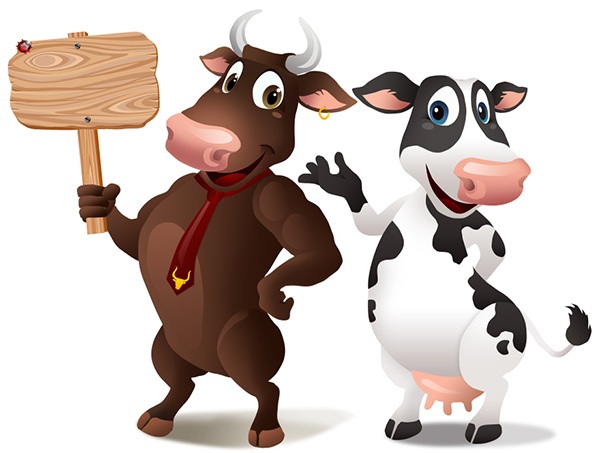
UPD 1:
After reading the comments from the category: "And my hell is buggy / slows down / flies," I decided to conduct a three-hour designer test drive.
Baseline: 8 independent computers are involved, of which
- 4 stationary (3 PC and 1 Mac)
- 4 laptops (2 PCs and 2 MacBooks - Air and Pro)
What we found out:
1) Oddly enough, the most unstable Mac, although it would seem.
Pro, of course, behaved more decently than a lightweight fellow, but at 4 gigs of RAM, it significantly slowed down for Paragraph Styles and Bridge (which was not noticed before).
Air after two hours of active work tightly stuck and flew out. The owner of the laptop was clearly experiencing culture shock, since, in his words: “This has never happened before!”. Makovsky desktop monoblock was more active, but in Paragraph Styles also did not behave particularly well, and in 3D showed very poor results.
2) PC a little better. Naturally, there were precedents for disabling GPU - acceleration in the process of working with 3D, and with the style libraries everything is not normal. At some stage, the volumetric source files that had flown before suddenly began to open longer. One of the laptops had a funny incident: in the process of work, the anti-virus database was suddenly updated, which finally demolished Adobe ID, which led to the need to re-register Photoshop and for some reason reset the user settings.
But then, in retaliation, apparently, this laptop with hybrid graphics tore its stationary colleague to shreds with a more than decent 1 GB discrete image on the speed of application of package styles.
Total: minimal decent results with the active work of Photoshop CS6 issued on:
- PC
- Core i3 (and 2 Duo proved even worse than Duo, which surprised us incredibly)
- Windows 7 x 64
- RAM: 8 GB
- 1 GB video card
By the way, it was a laptop.
Source: https://habr.com/ru/post/142416/
All Articles